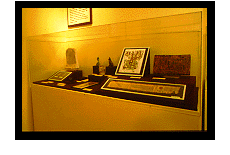![]()
 To some extent, the gendered activities of Egyptian
deities mirrored the lives of their mortal worshippers. Thus, the kings,
rulers, fighters, and administrators of the gods tend to be male, while
goddesses serve as queens, nurturers, childbearers, and protectors of the
gods. Some goddesses served merely as characterless consorts to gods, but
others assumed special functions. Isis not only embodied the idea of motherhood
but was also endowed with exceptional magical powers. Hathor was a popular
goddess associated with music, dancing, and pleasure but also had a wrathful
aspect that could threaten to destroy humanity. The sky was the body of
the goddess Nut, while storms were personified by goddesses like Sakhmet
and Tefnut. Divine personifications of abstract concepts tended to be goddesses,
the best-known being Ma'at, the personification of truth, order, and the
like. Goddesses were often identified with animals that embodied qualities
associated with the deity.
To some extent, the gendered activities of Egyptian
deities mirrored the lives of their mortal worshippers. Thus, the kings,
rulers, fighters, and administrators of the gods tend to be male, while
goddesses serve as queens, nurturers, childbearers, and protectors of the
gods. Some goddesses served merely as characterless consorts to gods, but
others assumed special functions. Isis not only embodied the idea of motherhood
but was also endowed with exceptional magical powers. Hathor was a popular
goddess associated with music, dancing, and pleasure but also had a wrathful
aspect that could threaten to destroy humanity. The sky was the body of
the goddess Nut, while storms were personified by goddesses like Sakhmet
and Tefnut. Divine personifications of abstract concepts tended to be goddesses,
the best-known being Ma'at, the personification of truth, order, and the
like. Goddesses were often identified with animals that embodied qualities
associated with the deity.
The coming of Greek religion in the Graeco-Roman period brought new gods and goddesses and new religious traditions to Egypt, but the old traditions remained active; indeed, the two were often combined. Thus, the Greek goddess Aphrodite was worshipped alongside the Egyptian goddess Isis, and the attributes of the two were merged in Isis-Aphrodite. By the fourth century CE Christianity had gradually supplanted the older religions, but the iconography of early Christianity adapted many earlier forms, and the old Egyptian gods and goddesses were still evoked in magical texts.
Throughout ancient Egyptian history, roles in religious employment were connected to the gender of the employee. In general, men were in charge of temples and their administration, but women filled a variety of religious offices in the Pharaonic period, especially as priestesses associated with the cults of such goddesses as Hathor. By the New Kingdom, however, the priesthood had become part of the state bureaucracy, which excluded women. As if to compensate, we find an increase in the number of elite women associated with temples as "musicians" of a particular deity. In the Graeco-Roman period, women filled various priestly roles. Under Christianity, however, they were again excluded from formal religious office in Egypt. Female officiants were often associated with the cults of female deities, although by far the most common female religious titles relate to the worship of male gods. Similarly, male priests often officiated for goddesses.
Perhaps the best-attested religious practices of the ancient Egyptians are those connected with death and burial. The Egyptians conceived of the afterlife as an extension of their daily life on earth that had to be carefully planned for. The dead body was prepared and protected, both through physical embalming and through funerary texts designed to ensure a smooth transition to the afterlife. Artifacts of the Egyptian preparations for life after death show this to have been an endeavor open to both men and women. Preparations for the afterlife also invoked the specific protection of goddesses such as Isis and Nut; in general, goddesses tended to serve as protectors of the dead.
![]()